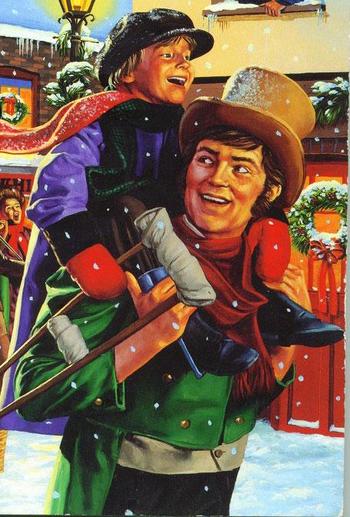Things Your Writing Teacher Never Told You: Season’s Greetings: Some Recommendations To Warm Your Cold Cockles
Regardless of whether you’re more a Scrooge or a Tiny Tim, I’ve got two recommendations that make perfect reading for the season (and a viewing and listening recommendation, if you haven’t got time to read both books).
The first is Hogfather, by Terry Pratchett (available in HC, ppb & ebook), set in the popular Discworld series. If there are still F/SF readers who haven’t encountered this quirky world before, it is a place much like our own. Magic may be real, but the wizards and witches and guards on the City Watch are as human, and eccentric, as any neighbor you’d want to meet. Pratchett’s novels defy fantasy conventions and rise above any preconceptions you might have about that sort of novel. They’re funny, and filled with wry social commentary and compassion for human weakness.
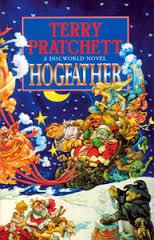 Hogfather is the 20th book in the series, but it’s a fine place to start. It’s the night before Hogswatch – a winter holiday that features decorated trees and a man in a long white beard and red overcoat who delivers toys to all (nearly all) good little girls and boys on a sleigh pulled by four flying wild boars. But this year the Assassins Guild has a contract out on him, and the Hogfather has gone missing. Susan the Governess has got to find him before morning, else the sun won’t rise. (Not to mention all the disappointed kiddies.) Her journey takes her through the Land of Death (her grandfather is the bony man who carries the hourglass and scythe), to the home of the Tooth Fairy (a rather disturbing place where your worst childhood fears come true), and back into time when the precursor to St. Nick/Hogfather was based in rather more violent seasonal traditions.
Hogfather is the 20th book in the series, but it’s a fine place to start. It’s the night before Hogswatch – a winter holiday that features decorated trees and a man in a long white beard and red overcoat who delivers toys to all (nearly all) good little girls and boys on a sleigh pulled by four flying wild boars. But this year the Assassins Guild has a contract out on him, and the Hogfather has gone missing. Susan the Governess has got to find him before morning, else the sun won’t rise. (Not to mention all the disappointed kiddies.) Her journey takes her through the Land of Death (her grandfather is the bony man who carries the hourglass and scythe), to the home of the Tooth Fairy (a rather disturbing place where your worst childhood fears come true), and back into time when the precursor to St. Nick/Hogfather was based in rather more violent seasonal traditions.
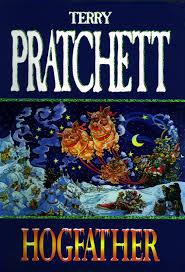 Hogfather explores the importance of belief and the wonder and magic of Christmas – and how it can bring out the best in everyone – as we see Death himself neglect his own duties to stuff a pillow under his rented red coat and trade in his white horse for a hog-drawn sleigh to fill in for his jolly old friend. Along the way, it explores a number of the holiday traditions and stories, and gently and lovingly pokes holes in them, including Good King Wenceslas, the Little Match Girl, Christmas caroling, hanging stockings, mistletoe — and whether it should be nicked or bought, why Santa doesn’t visit poor people, terrible presents, and the joys and travails of family holiday gatherings. It also explores the importance of belief. Hogfather, like Miracle on 34th Street, concludes, “Yes, Virginia, there IS a Santa Claus,” and that he plays a crucial role in our society.
Hogfather explores the importance of belief and the wonder and magic of Christmas – and how it can bring out the best in everyone – as we see Death himself neglect his own duties to stuff a pillow under his rented red coat and trade in his white horse for a hog-drawn sleigh to fill in for his jolly old friend. Along the way, it explores a number of the holiday traditions and stories, and gently and lovingly pokes holes in them, including Good King Wenceslas, the Little Match Girl, Christmas caroling, hanging stockings, mistletoe — and whether it should be nicked or bought, why Santa doesn’t visit poor people, terrible presents, and the joys and travails of family holiday gatherings. It also explores the importance of belief. Hogfather, like Miracle on 34th Street, concludes, “Yes, Virginia, there IS a Santa Claus,” and that he plays a crucial role in our society.
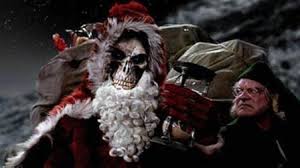 The BBC has recorded a “live action” version of the book that is quite good. While I’d never consider forgoing the printed version, the movie version is well worth tracking down.
The BBC has recorded a “live action” version of the book that is quite good. While I’d never consider forgoing the printed version, the movie version is well worth tracking down.
The second book (novella, really) is a classic – neglected in text form in favor of about a million inferior movies – A Christmas Carol by Charles Dickens. The novella is available in multiple formats and collections. Along with the classic story we all know and love, it has a wicked sense of humor and a social message that extends well beyond “Be nice to the people around you, and they’ll be nice to you!” moral that we see from the film and TV adaptions.
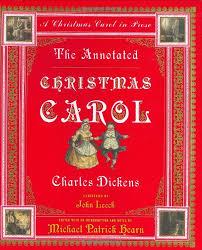 I recommend The Annotated Christmas Carol: along with side-by-side annotations about all manner of truly interesting things (this is not your high school annotations book), it also features a fair number of illustrations of the text from over the 170+ years of publication. But I acknowledge this book might be a bit daunting for folks doing their first read of the classic. You don’t need all the annotations to enjoy the original story. I’d read and loved the original novella six or eight times before I picked up the annotated version.
I recommend The Annotated Christmas Carol: along with side-by-side annotations about all manner of truly interesting things (this is not your high school annotations book), it also features a fair number of illustrations of the text from over the 170+ years of publication. But I acknowledge this book might be a bit daunting for folks doing their first read of the classic. You don’t need all the annotations to enjoy the original story. I’d read and loved the original novella six or eight times before I picked up the annotated version.
Ebenezer Scrooge has been played by Alstair Sim, George C. Scott, Michael Cain, Patrick Stewart… even Fred Flintstone. In all those versions they got the plot, but they didn’t quite capture the humor, or the heart, of the story.
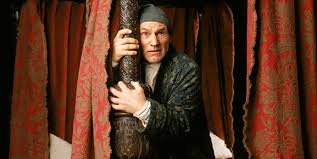 If you choose to indulge in a video version, I highly recommend the one starring Patrick Stewart. It is a gritty and authentic portrayal – here’s a man who truly needs an intervention!
If you choose to indulge in a video version, I highly recommend the one starring Patrick Stewart. It is a gritty and authentic portrayal – here’s a man who truly needs an intervention!
Even better is the hip and humorous version of Scrooged starring Bill Murray as a cut-throat cynical network TV VP. It features a strong supporting cast including Carol Kane as the faerie ghost of Christmas Present; David Johansen as a cigar-puffing, cab-driving Ghost of Christmas Past; Alfre Woodard, Robert Mitchum, John Houseman, and Bobcat Goldthwait among the network staff; Karen Allen as an old love who runs a homeless shelter frequented by a quirky group of alcoholics who provide a fair number of the laughs and a good deal of the pathos. There’s also a host of notable cameos. And the jokes poking fun at TV excesses are as relevant today as when they were written.
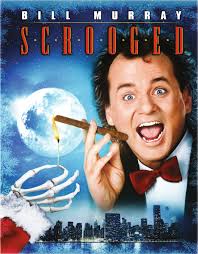 With its sly, dry wit and sharp social commentary, I believe it, of all the contenders, would be the version that Charles Dickens would most enjoy. I can practically recite the great Bill Murray monologue at the end, after he’s completed the gauntlet of the ghosts – all while trying to produce a massive, multi-country, live extravaganza TV production of “A Christmas Carol” (with Mary Lou Retton as Tiny Tim!).
With its sly, dry wit and sharp social commentary, I believe it, of all the contenders, would be the version that Charles Dickens would most enjoy. I can practically recite the great Bill Murray monologue at the end, after he’s completed the gauntlet of the ghosts – all while trying to produce a massive, multi-country, live extravaganza TV production of “A Christmas Carol” (with Mary Lou Retton as Tiny Tim!).
There are people who are having trouble making their miracle happen; there are people who don’t have enough to eat, there are people who are cold, you can go out and say hello to these people. You can take an old blanket out of the closet and go to them and say ‘Here!’, you can make them a sandwich and say ‘oh by the way, here!’ I get it now! Then if you GIVE, then it can happen, then the miracle can happen to you! It’s not just the poor and the hungry, it’s everybody who’s GOT to have this miracle! And it can happen tonight for all of you. If you believe in this spirit thing, the miracle will happen and then you’ll want it to happen again tomorrow. You won’t be one of these bastards who says ‘Christmas is once a year and it’s a fraud’, it’s NOT! It can happen every day, you’ve just got to want that feeling.
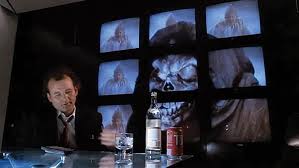 There are rumors I will neither confirm or deny that I cry every time they start singing the Jackie DeShannon song, “Put a Little Love in Your Heart” at the end – even though my husband and I have watched this film every Christmas season since it came out in 1988.
There are rumors I will neither confirm or deny that I cry every time they start singing the Jackie DeShannon song, “Put a Little Love in Your Heart” at the end – even though my husband and I have watched this film every Christmas season since it came out in 1988.
So, given my great love of Bill Murray and Scrooged, and the many adaptions starring any number of big name actors, why is the novella better? I could give you a reason for each of the Twelve Days of Christmas.
As a devoted fan of ghost stories, I deeply appreciate that all the ghost scenes are genuinely spooky in the novella, and not just the bits with the Ghost of Christmas Future. What the charwoman, the laundress, and the undertaker’s man do to Scrooge’s phantom corpse is far more chilling than any special effects graveyard scene.
Perhaps the most important is that most of the movies miss the heart of the lesson. Through the three ghosts of Christmas, Scrooge comes to care deeply for Bob Cratchit and Tiny Tim, even his nephew, Fred. But left at that, the message is self-serving; be nice to those around you and they’ll be nice to you. For all that some people really do need to be reminded of this lesson, if it stops there, it’s ultimately selfish.
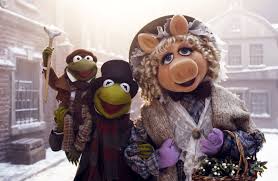 What’s left out for the sake of the movies’ running time is the emphasis on our social obligations to strangers, the poor, the lonely, the misfortunate. As Pratchett says in Hogfather, “Wouldn’t It Be Nice If Everyone Was Nice”? In the Dickens novella, the Ghost of Christmas Present takes Scrooge far and wide to spy on folks to learn this lesson. They visit miners on the cold moor, keepers in a distant lighthouse, sailors far out to sea. The Ghost spreads his joy, and all have warmer hearts and kindness on their lips. Scrooged, with the aspect of a multi-country, live TV extravaganza, at least nods at that – which is far more than most of the other film/TV adaptions do.
What’s left out for the sake of the movies’ running time is the emphasis on our social obligations to strangers, the poor, the lonely, the misfortunate. As Pratchett says in Hogfather, “Wouldn’t It Be Nice If Everyone Was Nice”? In the Dickens novella, the Ghost of Christmas Present takes Scrooge far and wide to spy on folks to learn this lesson. They visit miners on the cold moor, keepers in a distant lighthouse, sailors far out to sea. The Ghost spreads his joy, and all have warmer hearts and kindness on their lips. Scrooged, with the aspect of a multi-country, live TV extravaganza, at least nods at that – which is far more than most of the other film/TV adaptions do.
Dickens stresses that charity for strangers whom you will never meet, who will never know that you were the one who helped them, is an essential part of the lesson, is an essential part of the social contract. Don’t just help family, or close friends, or needful employees and their families. Do your part to help the world. Ebeneezer Scrooge’s views that prisons and workhouses are an adequate and appropriate social safety net for the poor and destitute has to be redeemed.
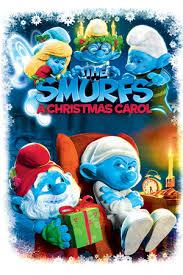 Finally, most of the films take the general motifs of the story – such as an uncaring father and a lost love – and update them, believing the original to be too British, too Victorian, too old fashioned. (With the exception of an occasional movie like Robin Williams’ Dead Poet’s Society, Hollywood views boarding schools as moribund and un-American. Or maybe because of those movies. But you get my point.) However, the original details and motifs are charming, and offer far more character development of how Ebenezer came to be… well, a Scrooge.
Finally, most of the films take the general motifs of the story – such as an uncaring father and a lost love – and update them, believing the original to be too British, too Victorian, too old fashioned. (With the exception of an occasional movie like Robin Williams’ Dead Poet’s Society, Hollywood views boarding schools as moribund and un-American. Or maybe because of those movies. But you get my point.) However, the original details and motifs are charming, and offer far more character development of how Ebenezer came to be… well, a Scrooge.
We see how life had beaten him down repeatedly. So we come to care far more deeply about him that we ever could watching the movies that skip lightly over that backstory, touching on the tropes but never going in too deep, and instead focus on the Grinch he turned into. For many of those portrayals, we don’t like Ebeneezer enough to want him to redeem himself and be happy. But in the novella, because we care for that abandoned little boy, we celebrate with the man when, through ghostly-intervention and self-examination, he is lifted up again. That, to me, is what the Christmas Spirit is all about.
Of course, there is one final, awesome option between reading the original novella and watching any of the inferior TV or film adaptions. Charles Dickens did highly acclaimed live readings of his classic to packed theaters. And now, thanks to the New York Public Library, we can listen to Neil Gaiman read the piece, working from Dickens’ own annotated performance script. It’s available to listen to free right here.
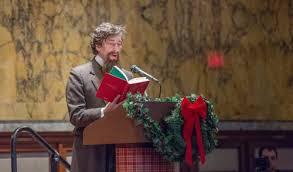 In a time when wealth is hoarded now more than ever, and when the wealthy and the politicians who represent them are saying that prisons and workhouses are fine social safety nets, our country simply can’t afford welfare, and anyone who needs it is really just lazy and undeserving and should just get a job anyway… well, to quote one of the lesser, but relevant, seasonal songs, “We need a little Christmas, right this very minute…” And you’ll find an abundance of it, in both Hogfather and A Christmas Carol: two books that can warm even the smallest, coldest hearts. So don’t be a grinch; go read one of these classics.
In a time when wealth is hoarded now more than ever, and when the wealthy and the politicians who represent them are saying that prisons and workhouses are fine social safety nets, our country simply can’t afford welfare, and anyone who needs it is really just lazy and undeserving and should just get a job anyway… well, to quote one of the lesser, but relevant, seasonal songs, “We need a little Christmas, right this very minute…” And you’ll find an abundance of it, in both Hogfather and A Christmas Carol: two books that can warm even the smallest, coldest hearts. So don’t be a grinch; go read one of these classics.
Tina L. Jens has been teaching varying combinations of Exploring Fantasy Genre Writing, Fantasy Writing Workshop, and Advanced Fantasy Writing Workshop at Columbia College-Chicago since 2007. The first of her 75 or so published fantasy and horror short stories was released in 1994. She has had dozens of newspaper articles published, a few poems, a comic, and had a short comedic play produced in Alabama and another chosen for a table reading by Dandelion Theatre in Chicago. Her novel, The Blues Ain’t Nothin’: Tales of the Lonesome Blues Pub, won Best Novel from the National Federation of Press Women, and was a final nominee for Best First Novel for the Bram Stoker and International Horror Guild awards.
She was the senior producer of a weekly fiction reading series, Twilight Tales, for 15 years, and was the editor/publisher of the Twilight Tales small press, overseeing 26 anthologies and collections. She co-chaired a World Fantasy Convention, a World Horror Convention, and served for two years as the Chairman of the Board for the Horror Writers Assoc. Along with teaching, writing, and blogging, she also supervises a revolving crew of interns who help her run the monthly, multi-genre, reading series Gumbo Fiction Salon in Chicago. You can find more of her musings on writing, social justice, politics, and feminism on Facebook @ Tina Jens. Be sure to drop her a PM and tell her you saw her Black Gate blog.
